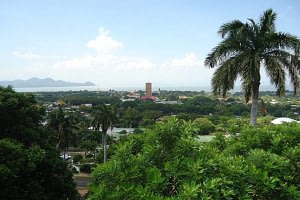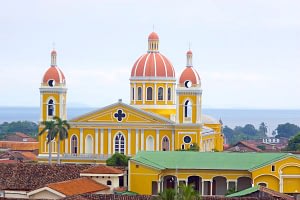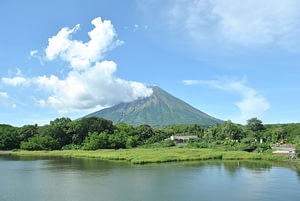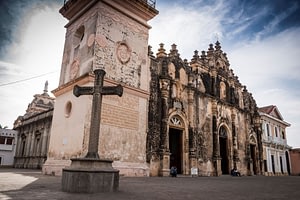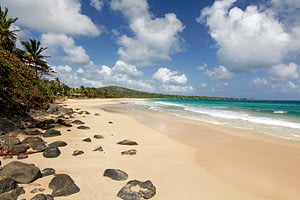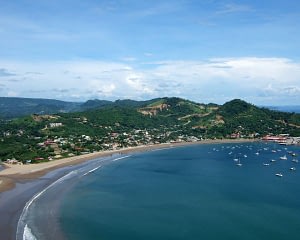Explore the diverse highlights of Nicaragua, from rugged coastlines to candy-coloured colonial facades. Read more below about our favourite places to discover during a trip to this lesser-explored gem of Central America. When you're ready to plan your own adventure, you can choose from our suggested itineraries and combine with our responsible experiences for an unforgettable holiday with a positive impact.
Managua, on the south shore of Lake Managua, is the capital city of Nicaragua. Its cathedral, a shell since a 1972 earthquake, is on the Plaza of the Revolution. Nearby is the tomb of Sandinista leader Carlos Fonseca. The 1935 National Palace of Culture houses the National Museum. Hilltop Parque Histórico Nacional Loma de Tiscapa is known for its crater lake and huge statue of revolutionary Augusto Sandino.
In the lakeside Acahualinca neighborhood, the Huellas de Acahualinca are fossilized tracks of people and animals from 6,000 years ago, preserved in volcanic mud. A museum contains other relics found during excavations of the site. Southeast of town, Masaya Volcano National Park offers views of the active volcano crater. Close by, Chocoyero-El Brujo Nature Reserve is home to forest trails and wildlife, including howler monkeys. The reserve encompasses the waterfalls El Brujo, with waters that seem to disappear underground, and Chocoyero, drawing flocks of green Pacific parakeets.
Granada is a Nicaraguan city on the shores of Lake Nicaragua. It’s home to multiple Spanish colonial landmarks that have survived repeated pirate invasions. The city’s main plaza, Central Park, is dominated by the colorful, neoclassical facade of the Cathedral of Granada, originally dating to 1583. The Centro Cultural Convento San Francisco nearby is famed for its displays of pre-Columbian statues.
From the bell tower of Iglesia de la Merced, a baroque church that was first built in 1534, visitors can admire the city, lake and the nearby 1,400m-high Mombacho Volcano. Built by the Spanish in 1748, Fortaleza de la Pólvora is a former fortress turned military museum that also provides panoramic views. Beyond Granada, Las Isletas is a roughly 350-island archipelago popular with kayakers and bird-watchers. To the south lies the Mombacho Volcano Nature Reserve, which offers hiking trails around the volcano’s rim, as well as canopy tours.
Ometepe is an island in southwest Nicaragua’s vast Lake Nicaragua. It's known for its twin volcanoes. The active Concepción Volcano is in the island’s north. South, trails lead up Maderas Volcano to San Ramón Waterfall. Ometepe Museum, in the town of Altagracia, has ancient petroglyphs. Santo Domingo Beach is known for its choppy surf. At the nearby Ojo de Agua, natural pools are fed by a spring.
León is a city in western Nicaragua. The massive León Cathedral combines baroque and neoclassical architecture. Nearby, the Centro de Arte Fundación Ortiz-Gurdián, in 2 colonial-era houses, is notable for its collection of Latin American and European contemporary art. East, near the base of Momotombo Volcano, are the ruins of the medieval city of León Viejo. Other volcanoes in the area include Cerro Negro.
Among the city’s notable churches is the striking, yellow, baroque Iglesia de la Recolección. The Rubén Darío Museum, the prominent poet’s childhood home in the late 19th century, displays manuscripts and artifacts. Southwest of León, the Juan Venado Nature Reserve has long beaches and mangrove forests. It’s a habitat for nesting sea turtles as well as birds like pelicans, herons and egrets. Turtles also nest in the Estero Padre Ramos Nature Reserve, a protected coastal wetland to the northwest.
Lying between Managua and Granada, Masaya Volcano National Park is a fascinating place to visit, en route between the two cities or as a day trip from either one.
The main attraction is the huge Santiago crater which has formed between the Nindiri and Masaya volcanoes. Throughout the 1900s there were frequent eruptions until, in 1985, the craters collapsed; even now sulphurous gasses still bellow forth and you can hear the lava thundering past below ground.
Surrounding the national park are some fascinating little market and craft towns worth exploring.
Isolated off Nicaragua’s Caribbean coast are two small islands ringed by palm trees and white sand beaches: the Corn Islands.
Undeveloped, peaceful, incredibly laid-back and English speaking, here the Caribbean casts its lilt on Nicaragua’s own culture.
There is little in the way of hotels and infrastructure but intrepid travellers are rewarded by pristine beaches and some of the best diving and snorkelling in the Caribbean.
The friendly fishing town of San Juan del Sur is located on Nicaragua’s Pacific coast. The town's horseshoe shaped bay is now one of Nicaragua's main tourist destinations along with the colonial city of Granada, but despite its popularity it has not lost any of its charm and retains its identity as a small, sleepy fishing village.
It is set on a crescent shaped bay flanked by steep, rocky headlands covered in thick forest. Its main activity is fishing and numerous small local restaurants are set on the town's beach serving excellent fresh local seafood.
Although the town's beach is not the tropical idyll you may be expecting, overlooked by the new development projects in the area, there are plenty of pristine, empty beaches to explore further a field. El Coco, Chococente, El Astillero and La Flor are some of the most beautiful and the coastline here is amongst the most picturesque in Central America.

